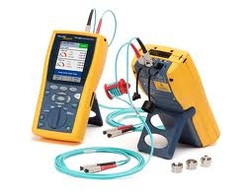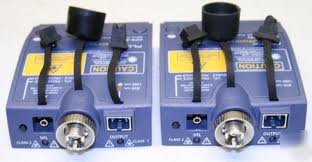Cable certifications
Certifying copper and fiber cabling prevents problems. Certification is insurance against future problems. Without it, repairs must be made on a live network or worse, on a network suffering an outage.
A network owner may be tempted to roll the dice in tough times and use a manufacturer’s warranty as a security blanket. This is understandable because most cable and connector manufacturers offer good warranties and they stand behind their products. These manufacturers cannot, though, warranty final installation.The only way to assure that installer workmanship meets standards is by certification testing. The only way to assure that best practices are followed is by certification testing. Certification gives the network owner protection against unanticipated costs. When the economics winds blow ill, protection is welcome.
A recertified cabling plant may prove to support higher-speed traffic that is deployed years after the cable is first installed. What are the implications of this? Category 6 copper cable was designed to support 1-Gigabit per second data rate. Recent field certification tests indicate that a good deal of the Cat 6 cable used in datacenters complies with the 10GBASE-T standard and can support 10-Gigabit service over short to moderate distances. If you recertify the Cat 6 cable in your datacenter you may find an efficient path to a 10X throughput, avoiding some or all of the cost of replacing cable.
When a new occupant enters a building the state of its cabling presents a series of questions. How old is it? Does it work? What was it used for? When? A new tenant may view the mass of copper and/or fiber as a mystery, not an asset. Certification is life extension for a cable plant. It is capital saved for building owners and tenants. Lack of certification turns legacy cabling into stranded capital.
The widely adopted National Electrical Code (NEC 2002) requires the removal of abandoned cable that is not identified for future use. Without certification the cost legacy cable may well include the cost of cable removal, the cost of cable recycling and/or the environmental impact of disposal. It is sound business policy to maximize use of existing copper and fiber cable. When properly maintained it has a long lifespan.
An unsettling trend in the cable industry relates to “no-name” Cat 5, 6, and 6A product. This cable is often made outside the United States and is less expensive than comparable product from major manufactures. Unfortunately, much of this inexpensive cable is made from inferior materials using questionable manufacturing processes. To ensure that there are no costs or risks hidden in inexpensive Cat 5, 6, and 6A cable, enterprises and cable installers should certify cable in accordance with industry standards.
Conclusion Cabling that is certified has far more value than cabling that is uncertified. The amount of the additional value depends on application and the enterprise. Consider the pitfalls of uncertified cabling. Consider the trade-off between testing and “hoping for the best”. Hope is rarely a good strategy, and in a challenging economy, it is a dangerous one.
A network owner may be tempted to roll the dice in tough times and use a manufacturer’s warranty as a security blanket. This is understandable because most cable and connector manufacturers offer good warranties and they stand behind their products. These manufacturers cannot, though, warranty final installation.The only way to assure that installer workmanship meets standards is by certification testing. The only way to assure that best practices are followed is by certification testing. Certification gives the network owner protection against unanticipated costs. When the economics winds blow ill, protection is welcome.
A recertified cabling plant may prove to support higher-speed traffic that is deployed years after the cable is first installed. What are the implications of this? Category 6 copper cable was designed to support 1-Gigabit per second data rate. Recent field certification tests indicate that a good deal of the Cat 6 cable used in datacenters complies with the 10GBASE-T standard and can support 10-Gigabit service over short to moderate distances. If you recertify the Cat 6 cable in your datacenter you may find an efficient path to a 10X throughput, avoiding some or all of the cost of replacing cable.
When a new occupant enters a building the state of its cabling presents a series of questions. How old is it? Does it work? What was it used for? When? A new tenant may view the mass of copper and/or fiber as a mystery, not an asset. Certification is life extension for a cable plant. It is capital saved for building owners and tenants. Lack of certification turns legacy cabling into stranded capital.
The widely adopted National Electrical Code (NEC 2002) requires the removal of abandoned cable that is not identified for future use. Without certification the cost legacy cable may well include the cost of cable removal, the cost of cable recycling and/or the environmental impact of disposal. It is sound business policy to maximize use of existing copper and fiber cable. When properly maintained it has a long lifespan.
An unsettling trend in the cable industry relates to “no-name” Cat 5, 6, and 6A product. This cable is often made outside the United States and is less expensive than comparable product from major manufactures. Unfortunately, much of this inexpensive cable is made from inferior materials using questionable manufacturing processes. To ensure that there are no costs or risks hidden in inexpensive Cat 5, 6, and 6A cable, enterprises and cable installers should certify cable in accordance with industry standards.
Conclusion Cabling that is certified has far more value than cabling that is uncertified. The amount of the additional value depends on application and the enterprise. Consider the pitfalls of uncertified cabling. Consider the trade-off between testing and “hoping for the best”. Hope is rarely a good strategy, and in a challenging economy, it is a dangerous one.

Fiber Optic cable certifications:
- We use the Fluke DTX1800 CableAnalyzer
- We certify single-mode & both types of multi-mode, 50um & 62.5um
- We certify single-mode in both wavelengths, 1310nm & 1550nm
- We certify multi-mode in both wavelengths, 850 & 1300
- All results are delivered in PDF format
- We use the Fluke DTX1800 CableAnalyzer
- We certify all categories of copper cabling, up to 6A F/UTP
- Results delivered in PDF format

